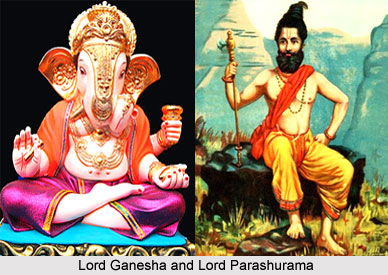 The Legend of Lord Ganesha and Parashurama is mentioned in the Brahmanda Purana, which is one of the ancient Hindu Mahapuranas. The tale describes the fierce battle between Lord Ganesha and Lord Parashurama. Ganesha is the son of Lord Shiva and Goddess Parvati and is also known as Pillaiyar, Ganapati and Vinayaka. He is regarded as the deity of new ventures, wisdom and success; and is considered as the Remover of Obstacles and Lord of Beginnings. Lord Parashurama is the 6th incarnation of Lord Vishnu in Treta Yuga and is one of the 7 Chiranjivis or immortal humans who remain alive throughout the present Kali Yuga. After deep meditation and worship, Lord Parashurama was granted a divine axe (Parashu) to please Lord Shiva. He was born to teach wisdom to the Kshatriya class of warriors who had become arrogant and oppressed clan.
The Legend of Lord Ganesha and Parashurama is mentioned in the Brahmanda Purana, which is one of the ancient Hindu Mahapuranas. The tale describes the fierce battle between Lord Ganesha and Lord Parashurama. Ganesha is the son of Lord Shiva and Goddess Parvati and is also known as Pillaiyar, Ganapati and Vinayaka. He is regarded as the deity of new ventures, wisdom and success; and is considered as the Remover of Obstacles and Lord of Beginnings. Lord Parashurama is the 6th incarnation of Lord Vishnu in Treta Yuga and is one of the 7 Chiranjivis or immortal humans who remain alive throughout the present Kali Yuga. After deep meditation and worship, Lord Parashurama was granted a divine axe (Parashu) to please Lord Shiva. He was born to teach wisdom to the Kshatriya class of warriors who had become arrogant and oppressed clan.
The legend states that once Lord Parashurama visited Lord Shiva in his heavenly abode in Mount Kailash. But Ganesha, who was created as a guard of Goddess Parvati, prevented him from entering. The elephant headed deity asked him to obtain Lord Shiva`s permission before entering his abode. This greatly angered Parashurama who threw his divine axe at Ganesha, who knew it was granted by his father Shiva, and thus allowed the axe to chop up one of his tusks. Goddess Parvati, the consort of Lord Shiva, became infuriated upon discovering that a tusk of his elder son was cut off. She announced that she would cut off both the arms of Parashurama and slay him if his thirst for the blood of the Kshatriyas was still not contented.
Goddess Parvati (Uma) then took the avatar of Shakti (The Great Divine Mother) and therefore became the ultimate source of Power. None of the other divine powers could match or resist the power of Shakti. Then Lord Shiva appeared at the scene and tried to appease Parvati. He persuaded her not to harm Parashurama as he is also like her son and convinced her to forgive him as a Mother. Parashurama bowed down to Shiva, Parvati and Ganesha and asked for forgiveness.
Eventually Parvati forgave Lord Parashurama at the request of Lord Ganesha. Parashurama then offered his divine axe to Lord Ganesha and blessed him. After this incident, Ganesha was also known as Ekadanta, meaning The Lord with a Single Tusk.




















